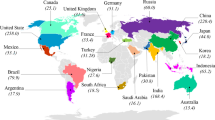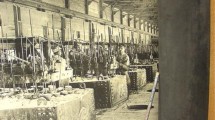Abstract
The influence of the blending ratio of pyrolyzed semi-char (SC) on the ignition, NO emission and burnout characteristics of lignite co-fired with SC was investigated in a 350 kW fuel-rich/lean combustion furnace. The flame temperature and concentrations of gaseous species including O2, CO, and NO, were measured in detail. The results indicated that the ignition characteristics of the blended fuel worsened with increasing SC blending ratio, such as an elongated ignition standoff distance. The addition of SC to lignite delayed the appearance of a stable flame boundary, and the stable combustion zone moved down, but the final combustion stability was gradually strengthened in the later combustion stage. NO emission concentration at the primary combustion zone (PCZ) outlet was the lowest at 472.6 mg/m3@6% O2 when the SC blending ratio was 25%. The combustion zone and reducing zone areas in PCZ were defined to evaluate the NO reduction characteristics, and quantitative analysis using a multiple linear regression model showed that heterogeneous reduction was more important than homogeneous reduction in lowering NO emissions. The Raman spectrum of the char sample indicated that the addition of lignite promoted the formation of small aromatic rings in the early ignition stage, corresponding to a higher char reactivity. The burnout ratio of pure lignite was maximal and was decreased by increasing the SC blending ratio. Synthetically, considering the ignition standoff distance, NO emission, and burnout ratio, the optimum SC blending ratio was estimated to be 25%.
Similar content being viewed by others
References
Gong Z.Q., Zhou T., Lyu Q.G., et al., Combustion and NOx emission characteristics of shenmu char in a circulating fluidized bed with post-combustion. Energy & Fuels, 2016, 30(1): 31–38.
Yao Y., Lyu Q.G., Zhu J.G., et al., Experimental study on preheating process of fine char in a circulating fluidized bed. Proceedings of the CSEE, 2015, 35(17): 4417–4422.
Ulloa C., Borrego A.G., Helle S., et al., Char characterization and DTF assays as tools to predict burnout of coal blends in power plants. Fuel, 2005, 84(2–3): 247–257.
Rao Z.H., Zhao Y.M, Huang C.L., et al., Recent developments in drying and dewatering for low rank coals. Proggess in Energy and Combustion Science, 2015, 46: 1–11.
Rubiera F., Arenillas A., Arias B., et al., Modification of combustion behaviour and NO emissions by coal blending. Fuel Processing Technology, 2002, 77–78: 111–117.
Caruso G., Vitale D.M.D., Naviglio A., Film condensation in inclined tubes with noncondensable gases: An experimental study on the local heat transfer coefficient. International Communications in Heat and Mass Transfer, 2013, 45: 1–10.
Dios M., Souto J.A., Casares J.J., Experimental development of CO2, SO2 and NOx emission factors for mixed lignite and subbituminous coal-fired power plant. Energy, 2013, 53: 40–51.
Vhathvarothai N., Ness J., Yu J., An investigation of thermal behaviour of biomass and coal during co-combustion using thermogravimetric analysis (TGA). International Journal of Energy Research, 2014, 38: 804–812.
Mundike J., Collard F.X., Görgens J.F., Co-combustion characteristics of coal with invasive alien plant chars prepared by torrefaction or slow pyrolysis. Fuel, 2018, 225: 62–70.
Ding G.C., He B.S., Y. H.F., et al., Co-combustion behaviors of municipal solid waste and low-rank coal semi-coke in air or oxygen/carbon dioxide atmospheres. Journal of Thermal Analysis and Calorimetry, 2019, 143: 619–635.
Zhang J.P., Jia X.W., Wang C.A., et al., Experimental investigation on combustion and NO formation characteristics of semi-coke and bituminous coal blends. Fuel, 2019, 247: 87–96.
Hu L.L., Zhang Y., Chen D.G., et al., Experimental study on the combustion and NOx emission characteristics of a bituminous coal blended with semi-coke. Applied Thermal Engineering, 2019, 160: 113993.
Kamal M.M., Parametric study of combined premixed and non-premixed flame coal burner. Fuel, 2008, 87(8): 1515–1528.
Kamal M., Combustion characteristics of pulverized coal and air/gas premixed flame in a double swirl combustor. Combustion Science and Technology, 2009, 181(1): 136–158.
Elfeky A.Y., Abdelkalek M., Kamal M., Pulverized coal combustion with opposing/cross-flow methane/air mixtures. Proceedings of the Institution of Mechanical Engineers, Part A: Journal of Power and Energy, 2014, 228: 688–707.
Yuan Y., Li S.Q., Yao Q., Experimental and numerical analyses on ignition and burnout characteristic of low-rank lignite and semi-char blends. The 8th International Symposium on Coal Combustion. Beijing, 2015: 69–74.
Huang Q., Li S.Q., Li G.D., et al., Reduction of fine particulate matter by blending lignite with semi-char in a down-fired pulverized coal combustor. Fuel, 2016, 181: 1162–1169.
Zeng G., Sun S., Dong H.M., et al., Effects of combustion conditions on formation characteristics of particulate matter from pulverized coal bias ignition. Energy Fuels, 2016, 30(10): 8691–8700.
Li Z.Q., Li S., Zhu Q.Y., et al., Effects of particle concentration variation in the primary air duct on combustion characteristics and NOx emissions in a 0.5-MW test facility with pulverized coal swirl burners. Applied Thermal Engineering, 2014, 73(1): 859–868.
Zhang J.W., Kelly K.E., Eddings E.G., et al., Ignition in 40 kW co-axial turbulent diffusion oxy-coal jet flames. Proceedings of the Combustion Institute, 2011, 33(2): 3375–3382.
Binner E., Zhang L., Li C.Z., et al., In-situ observation of the combustion of air-dried and wet victorian brown coal. Proceedings of the Combustion Institute, 2011, 33(2): 1739–1746.
Zhang J.W., Kelly K.E., Eddings E.G., et al., CO2 effects on near field aerodynamic phenomena in 40 kW, co-axial, oxy-coal, turbulent diffusion flames. International Journal of Green Gas Control, 2011, 5: S47–S57.
Li Z.Q., Liu C.L., Zhu Q.Y., et al., Experimental studies on the effect of the pulverized coal concentration on lean-coal combustion in a lateral-ignition tiny-oil burner. Energy & Fuels, 2010, 24(8): 4161–4165.
Khatami R., Levendis Y.A., An overview of coal rank influence on ignition and combustion phenomena at the particle level. Combustion and Flame, 2016, 164: 22–34.
Thomas K.M., The release of nitrogen oxides during char combustion. Fuel, 1997, 76(6): 457–473.
Khatami R., Stivers C., Levendis Y.A., Ignition characteristics of single coal particles from three different ranks in O2/N2 and O2/CO2 atmospheres. Combustion and Flame, 2012, 159: 3554–3568.
Riaza J., Khatami R., Levendis Y.A., et al., Single particle ignition and combustion of anthracite, semi-anthracite and bituminous coals in air and simulated oxy-fuel conditions. Combustion and Flame, 2014, 161(4): 1096–1108.
Yu Q., Zhang L., Binner E., et al., An investigation of the causes of the difference in coal particle ignition temperature between combustion in air and in O2/CO2. Fuel, 2010, 89(11): 3381–3387.
Sung Y., Moon C., Eom S., et al., Coal-particle size effects on NO reduction and burnout characteristics with air-staged combustion in a pulverized coal-fired furnace. Fuel, 2016, 182: 558–567.
Jovanovic R., Milewska A., Swiatkowski B., et al., Sensitivity analysis of different devolatilisation models on predicting ignition point position during pulverized coal combustion in O2/N2 and O2/CO2 atmospheres. Fuel, 2012, 101: 23–37.
Aarna I., Suuberg E.M., A review of the kinetics of the nitric oxide-carbon reaction. Fuel, 1997, 76(6): 475–491.
Johnsson J.E., Formation and reduction of nitrogen oxides in fluidized-bed combustion. Fuel, 1994, 73(9): 1398–1415.
Nelson P. F., Kelly M.D., Wornat M.J. Conversion of fuel nitrogen in coal volatiles to NOx precursors under rapid heating conditions. Fuel, 1991, 70(3): 403–407.
Li X., Hayashi J.I., Li C.Z., FT-Raman spectroscopic study of the evolution of char structure during the pyrolysis of a Victorian brown coal. Fuel, 2006, 85(12): 1700–1707.
Acknowledgement
The authors are grateful for National Key Research and Development Program of China (NO. 2017YFB0602002).
Author information
Authors and Affiliations
Corresponding author
Rights and permissions
About this article
Cite this article
Yan, Y., Peng, Z., Sun, L. et al. Effects of Blending Ratio on Combustion and NO Emission Characteristics during Co-Firing of Semi-Char and Lignite in a 350 kW Pulverized Coal-Fired Furnace. J. Therm. Sci. 32, 1292–1305 (2023). https://doi.org/10.1007/s11630-023-1779-x
Received:
Published:
Issue Date:
DOI: https://doi.org/10.1007/s11630-023-1779-x




